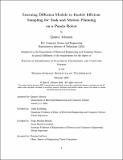| dc.contributor.advisor | Kaelbling, Leslie | |
| dc.contributor.advisor | Mendez-Mendez, Jorge | |
| dc.contributor.author | Johnson, Quincy | |
| dc.date.accessioned | 2025-04-14T14:08:27Z | |
| dc.date.available | 2025-04-14T14:08:27Z | |
| dc.date.issued | 2025-02 | |
| dc.date.submitted | 2025-04-03T14:06:18.304Z | |
| dc.identifier.uri | https://hdl.handle.net/1721.1/159141 | |
| dc.description.abstract | A search then sample approach to bilevel planning in the context of task and motion planning is one method of effectively solving multi-step robotics problems. In this planning framework, high-level plans of abstract actions are refined into low-level continuous transitions by sampling controller parameters associated with each action. Efficiently sampling these parameters remains a significant challenge, as exhaustive searches often become computational bottlenecks, especially for tasks requiring complex or multimodal parameter distributions. Moreover, relying on samplers hand-designed by humans is both impractical and limiting. To address these challenges, we propose using diffusion models to learn efficient sampling distributions from demonstrations. By avoiding the limitations of hand-specified and naïve sampling methods, our approach enhances planning efficiency and achieves superior performance across diverse tasks that require learning multimodal parameter distributions to solve successfully. | |
| dc.publisher | Massachusetts Institute of Technology | |
| dc.rights | In Copyright - Educational Use Permitted | |
| dc.rights | Copyright retained by author(s) | |
| dc.rights.uri | https://rightsstatements.org/page/InC-EDU/1.0/ | |
| dc.title | Learning Diffusion Models to Enable Efficient Sampling for Task and Motion Planning on a Panda Robot | |
| dc.type | Thesis | |
| dc.description.degree | M.Eng. | |
| dc.contributor.department | Massachusetts Institute of Technology. Department of Electrical Engineering and Computer Science | |
| dc.identifier.orcid | 0009-0005-7431-7769 | |
| mit.thesis.degree | Master | |
| thesis.degree.name | Master of Engineering in Electrical Engineering and Computer Science | |
